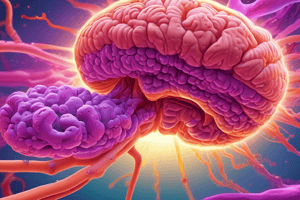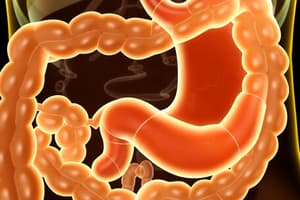Podcast
Questions and Answers
What are the two main parts of the pancreas?
What are the two main parts of the pancreas?
- Liver and gallbladder
- Stomach and esophagus
- Endocrine and exocrine (correct)
- Small and large intestines
Which of the following is NOT a part of the exocrine pancreatic secretion?
Which of the following is NOT a part of the exocrine pancreatic secretion?
- Digestive enzymes
- Bicarbonate ions
- Watery juice
- Insulin and glucagon (correct)
What is the pH of pancreatic juice and why?
What is the pH of pancreatic juice and why?
The pH of pancreatic juice is about 8. It is alkaline due to the high concentration of bicarbonate ions, which help to neutralize the acidic chyme entering the duodenum from the stomach.
Which of the following is the main hormone responsible for stimulating the secretion of the watery part of the pancreatic juice?
Which of the following is the main hormone responsible for stimulating the secretion of the watery part of the pancreatic juice?
Which of the following enzymes is NOT a proteolytic enzyme secreted by the pancreas?
Which of the following enzymes is NOT a proteolytic enzyme secreted by the pancreas?
Pancreatic proteolytic enzymes are activated in the pancreas before being secreted into the small intestine.
Pancreatic proteolytic enzymes are activated in the pancreas before being secreted into the small intestine.
Which one of the following correctly describes the function of trypsin inhibitor?
Which one of the following correctly describes the function of trypsin inhibitor?
Pancreatic amylase is responsible for the breakdown of ______.
Pancreatic amylase is responsible for the breakdown of ______.
Parasympathetic stimulation increases the production of the enzymatic part of the pancreatic juice.
Parasympathetic stimulation increases the production of the enzymatic part of the pancreatic juice.
What is the main function of cholecystokinin (CCK)?
What is the main function of cholecystokinin (CCK)?
Which of the following is NOT a common cause of exocrine pancreatic insufficiency (EPI)?
Which of the following is NOT a common cause of exocrine pancreatic insufficiency (EPI)?
What is the primary treatment for exocrine pancreatic insufficiency (EPI)?
What is the primary treatment for exocrine pancreatic insufficiency (EPI)?
What is the role of CFTR (Cystic Fibrosis Transmembrane Conductance Regulator) in the pancreas?
What is the role of CFTR (Cystic Fibrosis Transmembrane Conductance Regulator) in the pancreas?
Flashcards
Pancreas
Pancreas
A gland with two parts: endocrine (hormones) and exocrine (digestive enzymes).
Endocrine Pancreas
Endocrine Pancreas
The part of the pancreas that secretes hormones like insulin and glucagon.
Exocrine Pancreas
Exocrine Pancreas
The part of the pancreas that secretes digestive enzymes (pancreatic juice).
Pancreatic Juice
Pancreatic Juice
Signup and view all the flashcards
Pancreatic Duct
Pancreatic Duct
Signup and view all the flashcards
Ampulla of Vater
Ampulla of Vater
Signup and view all the flashcards
Sphincter of Oddi
Sphincter of Oddi
Signup and view all the flashcards
Pancreatic Bicarbonate
Pancreatic Bicarbonate
Signup and view all the flashcards
Exocrine Pancreatic insufficiency (EPI)
Exocrine Pancreatic insufficiency (EPI)
Signup and view all the flashcards
Daily volume of pancreatic juice.
Daily volume of pancreatic juice.
Signup and view all the flashcards
Pancreatic enzyme secretion
Pancreatic enzyme secretion
Signup and view all the flashcards
Proteolytic Enzymes
Proteolytic Enzymes
Signup and view all the flashcards
Watery part of pancreatic juice
Watery part of pancreatic juice
Signup and view all the flashcards
Carbonic anhydrase
Carbonic anhydrase
Signup and view all the flashcards
Bicarbonate ions
Bicarbonate ions
Signup and view all the flashcards
Sodium ions(Na+)
Sodium ions(Na+)
Signup and view all the flashcards
Study Notes
Pancreatic Exocrine Secretion
- The pancreas has two parts: endocrine (islets of Langerhans) and exocrine.
- The endocrine part secretes hormones like insulin and glucagon.
- The exocrine part is a compound acinar gland.
- It secretes pancreatic juice, collected by a duct system.
- The main duct joins the common bile duct, forming the ampulla of Vater, which opens into the duodenum.
- The opening is controlled by the sphincter of Oddi.
Pancreatic Juice Composition
- The watery part is rich in bicarbonate (HCO3−).
- It neutralizes the intestinal pH, enabling pancreatic and intestinal enzyme activity.
- It protects the duodenal mucosa from stomach acid (HCl).
- The enzymatic part is rich in digestive enzymes.
Pancreatic Bicarbonate Secretion
- When the pancreas is stimulated to secrete large amounts of pancreatic juice, the bicarbonate ion concentration rises significantly.
- Duct cells secrete sodium bicarbonate into the pancreatic ducts.
- This creates an osmotic pressure gradient, drawing water into the ducts.
Pancreatic Enzyme Secretion
- Proteolytic enzymes (e.g., trypsinogen, chymotrypsinogen, procarboxypeptidases, proelastase)
- Are secreted as inactive proenzymes.
- Become activated in the small intestine by enterokinase.
- Lipolytic Enzymes (e.g., pancreatic lipase, prophospholipase, cholesterolesterase).
- Lipolytic enzymes break down fats.
- Pancreatic amylase (CHO-splitting enzyme) breaks down carbohydrates.
- All proteolytic enzymes are secreted in inactive forms, crucial for preventing autodigestion of the pancreas.
Control of Pancreatic Secretion
-
Nervous Control:
- Parasympathetic (vagal) stimulation promotes enzyme secretion
- Sympathetic stimulation inhibits pancreatic secretion.
-
Hormonal Control:
- Secretin: Released in response to acidic chyme from the stomach. Stimulates the watery part (bicarbonate-rich) of pancreatic juice secretion.
- Cholecystokinin (CCK): Released in response to digestive products. Stimulates enzyme-rich pancreatic juice secretion.
Exocrine Pancreatic Insufficiency (EPI)
- Condition where the pancreas doesn't produce enough digestive enzymes.
- Leads to malabsorption of nutrients and vitamins.
- Symptoms include diarrhea, vitamin deficiencies, weight loss, abdominal pain, gas, bloating and fatty stools.
- Causes include pancreatic cancer, surgical removal, duct obstruction, chronic pancreatitis, cystic fibrosis.
Phases of Pancreatic Secretion
- Cephalic Phase: Vagal stimulation (smell, taste, or thinking about food)
- Gastric Phase: Presence of food in the stomach
- Intestinal Phase: When chyme enters the small intestine; secretin, CCK are crucial hormones involved.
Studying That Suits You
Use AI to generate personalized quizzes and flashcards to suit your learning preferences.




